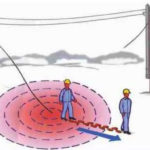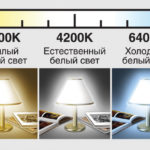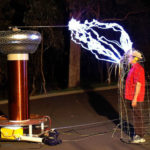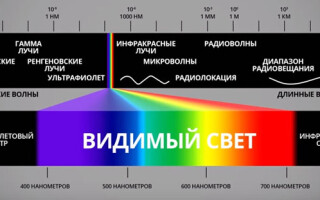Contents
- 1 What is Electromagnetic Radiation?
- 2 Scale of electromagnetic radiation
- 3 Main sources of electromagnetic radiation
- 4 Established standards for human exposure to electromagnetic radiation
- 5 Human exposure to electromagnetic radiation
- 6 Protection from electromagnetic radiation
- 7 How to check the level of electromagnetic radiation at home
What is electromagnetic radiation?
Electromagnetic radiation is the oscillation of electric and magnetic fields. The speed of propagation in a vacuum is equal to the speed of light (about 300,000 km/s). In other media, the speed of propagation of radiation is slower.
Electromagnetic radiation is classified into frequency ranges. The boundaries between the ranges are very conditional, there are no sharp transitions.
- Visible light. This is the narrowest range in the entire spectrum. A person can only perceive it. Visible light combines the colors of the rainbow: red, orange, yellow, green, blue, blue, and purple. Beyond red is infrared, beyond violet is ultraviolet, but these are no longer discernible to the human eye.
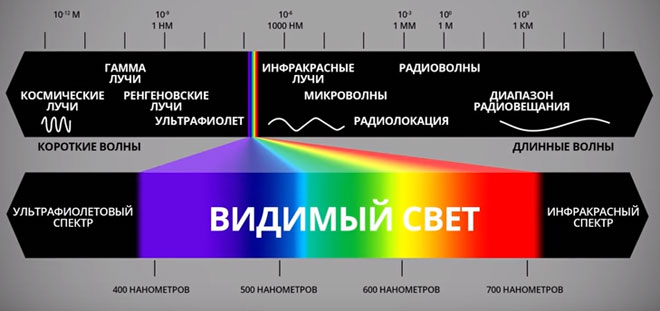
Waves of visible light are very short and high frequency. The length of these waves is one billionth of a meter, or one billion nanometers. Visible light from the Sun is a peculiar cocktail of three primary colors: red, yellow, and blue.
- Ultraviolet light. - Part of the spectrum between visible light and X-rays. Ultraviolet radiation is used to create lighting effects on theater stages, discos; some countries' banknotes contain security features that are only visible under ultraviolet light.
- Infrared radiation is part of the spectrum between visible light and short radio waves. Infrared radiation is heat rather than light: Every heated solid or liquid body emits a continuous infrared spectrum. The higher the heating temperature, the shorter the wavelength and the higher the intensity of the radiation.
- X-ray radiation (X-rays). Waves of X-rays have the property of passing through matter and not being absorbed too strongly. Visible light does not have this ability. Thanks to X-rays, some crystals can glow.
- Gamma radiation - are the shortest electromagnetic waves that pass through matter without absorption: they can overcome a one-meter wall of concrete and a lead barrier several centimeters thick.
IMPORTANT! X-rays and gamma rays should be avoided as they are potentially dangerous for humans.
Electromagnetic Radiation Scale
Processes occurring in space and objects that are there generate electromagnetic radiation. The wave scale is a method of recording electromagnetic emissions.
A detailed illustration of the spectral range is shown in the figure. The boundaries on this scale are conditional.

Main sources of electromagnetic radiation
- Power lines. At a distance of 10 meters they pose a threat to human health, so they are placed at a high height or buried deep in the ground.
- Electric vehicles. This includes electric cars, electric trains, subways, streetcars and trolleybuses, as well as elevators. The most harmful impact has the subway. It is better to travel on foot or by your own transport.
- Satellite system. Fortunately, strong radiation, colliding with the surface of the Earth, is dispersed, and only a small part of the danger reaches people.
- Functional transmitters: radars and locators. They emit an electromagnetic field at a distance of 1 km, so all the airports and weather stations are placed as far away from cities as possible.
Radiation from home electrical appliances
Widespread sources of electromagnetic radiation are household appliances that are in our homes.
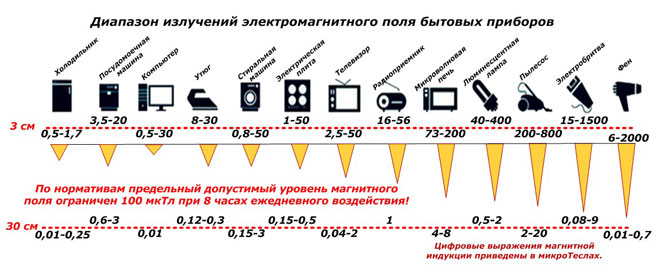
- Cell phones. The radiation from our smartphones does not exceed the established norms, but when we call someone, after dialing the number there is a connection between the base station and the phone. At this point, the rate is greatly exceeded, so bring your phone to your ear not immediately, but a few seconds after dialing a number.
- Computer. Radiation also does not exceed the norm, but for prolonged work the SanPin recommends a break for 5-15 minutes every hour.
- Microwave oven. The body of the microwave creates protection from radiation, but not 100%. It is dangerous to be near microwave ovens: the radiation penetrates under human skin for 2 cm, triggering pathological processes. During operation microwave oven Keep a distance of 1-1,5 meters from the microwave oven.
- TV. Modern plasma televisions are not very dangerous, but the old kinescope televisions should be wary and keep a distance of at least 1.5 meters.
- Hair dryer. When a hair dryer works, it creates an electromagnetic field of enormous strength. At this time, we dry our hair long enough and hold the hair dryer close to our head. To reduce the danger, use a hair dryer at most once a week. Drying your hair in the evening can cause insomnia.
- Electric shaver. Get a regular razor instead, or if you're used to it, a battery-powered electric razor. This will greatly reduce the electromagnetic load on the body.
- Chargers create a field in all directions at a distance of 1 meter. When charging your gadget, do not be close to it, and after charging, unplug the device from the socket so there is no radiation.
- Wiring and outlets. Cablesthat come off of electrical panels are a particular hazard. Maintain a distance of at least 5 meters from the cable to the sleeping area.
- Power-saving lamps also emit electromagnetic waves. This also applies to fluorescent and LED lamps. Install a halogen or incandescent bulb: they do not emit anything and are not dangerous.
Established EMI standards for humans
Every organ in our body vibrates. Through vibration, an electromagnetic field is created around us, contributing to the harmonious operation of the entire body. When our biofield is affected by other magnetic fields, it causes changes in it. Sometimes the body copes with the influence, sometimes not. This becomes the reason of worsening of our well-being.
Even a large accumulation of people creates an electric charge in the atmosphere. It is impossible to completely isolate yourself from electromagnetic radiation. There are permissible levels of EMI that are best not exceeded.
Here are the safe standards for health:
- 30-300 kHz, occurring at a field strength of 25 volts per meter (V/m),
- 0.3-3 MHz, at a field strength of 15 V/m,
- 3-30 MHz - intensity 10 V/m,
- 30-300 MHz - intensity 3 V/m,
- 300 MHz-300 GHz - intensity 10 μW/cm2.
Gadgets, radio and television equipment operate at these frequencies.
Human exposure to electromagnetic rays

The nervous system is extremely sensitive to the impact of electromagnetic rays: nerve cells reduce their conductivity. As a result, memory deteriorates, blunted sense of coordination.
When a person is exposed to electromagnetic radiation, not only is the immune system suppressed - it begins to attack the body.
IMPORTANT! Electromagnetic radiation poses a particular danger to pregnant women: the rate of fetal development decreases, defects in the formation of organs appear, the probability of premature birth is great.
Protection from electromagnetic radiation
- If you spend a lot of time at the computer, remember one rule: the distance between the face and the monitor should be about one meter.
- The level of electromagnetic radiation of the appliances you buy should not reach the "minimum" mark. Ask a sales consultant to help you choose the safest appliance. He will help you choose the safest appliances.
- Your bed should not be near where the wiring is. Place your bed at the opposite end of the room.
- Put a screen protector on your computer. This is in the form of a fine metal mesh and acts according to the Faraday principleIt: absorbs all radiation and protects the user.
- Reduce your exposure to electrified public transportation. Give preference to walking, bicycling.
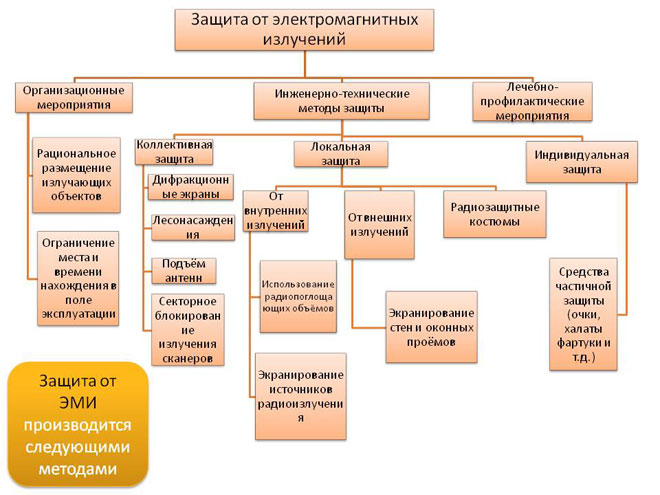
How to check the level of electromagnetic radiation at home
Only specialists can accurately outline how the situation with electromagnetic radiation in your home. When the Sanitary and Epidemiological Service receives an announcement that the permissible level of EMR has been exceeded, workers go to the site with special devices that allow them to obtain accurate data. The readings are processed. If they are too high, certain measures are taken. The first thing to do is to find out the cause of the problem. It can be an error in construction, design, improper operation.
To determine the degree of radiation by yourself, you will need screwdriver with indicator and a radio receiver.
- Slide the antenna out of the receiver;
- Screw a 40 cm diameter wire loop to it;
- Tune the radio to an empty frequency;
- Walk around the room. Listen to the sounds of the receiver;
- The place where you hear the distinct sounds is the source of the radiation;
- Hold up an indicator screwdriver with an LED. The LED will turn red and the intensity of the color will tell you the strength of the radiation.
A hand-held instrument will allow you to see the value in numbers. It operates at different frequencies and picks up electromagnetic field voltage. The instrument adjusts to the desired frequency mode by selecting the units of measurement: volts/meter or microwatts/cm2, tracks the selected frequency and outputs the result to the computer.
Also a good device is the ATT-2592. The device is portable and has a backlit display. The measurement performs isotropic method, automatically turns off after 15 minutes.
Related articles:
